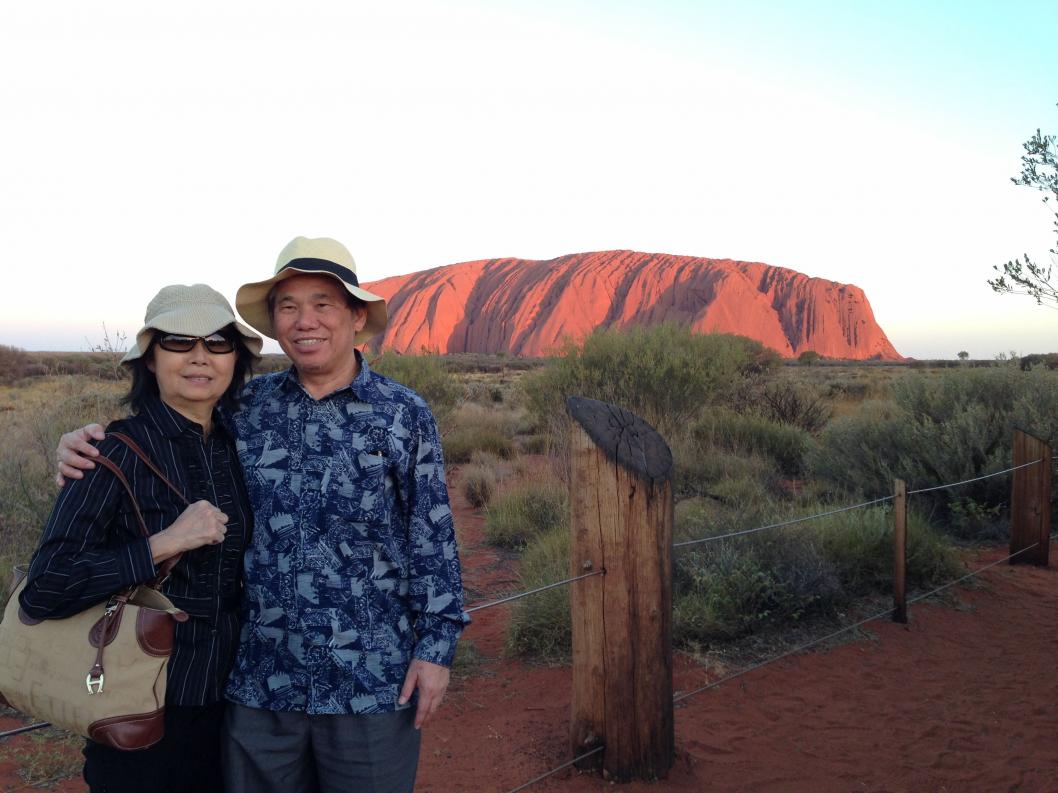VISITING TO CENTRAL AUSTRALIA

Grandmaster Wong and his wife in front of Ayers Rock or Uluru
My wife and I, with Michael (Sifu Michael Agar) and Caroline, visited the icon of Austrilia, i.e. Ayers Rock or Uluru in the aboriginal language, in the middle of the continent in November 2013. It was a memorable holiday as the many Australians themselves, by their own admission, have not been to this famous site. We flew from Melbourne to Uluru on 12th November 2013 and stayed there for two to three days.
Ayers Rock or Uluru, listed as a world heritage site, is a spiritual place for the local aboriginal people. It is one of the most recognizable natural landmarks of Australia, rising about 400 metres from the ground. It is famous for changing colours at different times of the day, but it is most remarkable when it glows red at dawn and sunset, which is also the time when most visitors view it.
Uluru is an inselbery, which means an island-mountain, and is often regarded as a monolith, which is a single large upright block of stone. We drove round Uluru which is about 10 kilometers.
We drove to Kata Tjuta, which is also known as the Olgas, about 25 km from Ayers Rock. Kata Tjuta or the Olgas is a group of large rock formations. The highest peak, Mount Olga, is about 1100 metres above sea level, or about 550 metres above the surrounding plain.
We saw the "Seven Sisters", which were rock formations resembling some women if you use some imagination. I told Michael that the Australians were good at the famous 36 strategies, though they might never have heard of the famous Chinese classic. At first Michael was a bit puzzled, but then he showed his ingenuity. "Yes, sifu" he said, "the Australians were good at creating something from nothing", recalling one of the famous strategies.
Then we visited the Kings Canyon with its hundred meter high sandstone walls with the Australian desert all around. Here Michael took the opportunity to show me the famous Australian wave, which was waving your hand from left to right, or vice versa, many times to keep away sand flies. The Australian desert was quite different from the North American desert in Nevada in the United States, or the Arabian desert in the Middle East.
We drove to Alice Springs, a small town in the centre of the Australian continent, which is sometimes called the Red Centre. The range of temperature in Alice Springs could be drastic, with a maximum temperature of about 35 degrees Celsius in summer and a minimum temperature of about 5 degrees Celsius in winter. But what impressed me most was when I was in school more than 50 years ago, I heard that the people in Alice Springs had to live underground as the desert weather above was too hot.
But when I arrived at Alice Springs, I found the statement of living underground not true. There were beautiful houses above ground and rows of pretty trees. There were also a lot of shops to do shopping. I did not carry a thermometer with me, but I found the weather pleasant.
Wong Kiew Kit
18th January 2018, Sungai Petani

Caroline and Michael
LINKS
Video Shows in Australia
